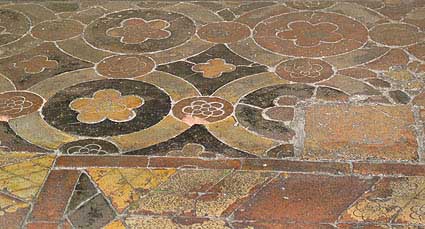Mosaic history, part 2 - Medieval to modern
 In the rest of Europe, mosaic went into general decline throughout the Middle Ages. However a flourishing tile industry led to mosaic tiling patterns in abbeys and other major religious buildings, for example. These tiles from Prior Crauden's Chapel at Ely Cathedral date from around 1320. The floor of the Chapel features a detailed tiled scene of Adam and Eve. As well as the interlocking patterns of tiles, there are some other mosaic techniques, including pseudo mosaic and opus sectile
In the rest of Europe, mosaic went into general decline throughout the Middle Ages. However a flourishing tile industry led to mosaic tiling patterns in abbeys and other major religious buildings, for example. These tiles from Prior Crauden's Chapel at Ely Cathedral date from around 1320. The floor of the Chapel features a detailed tiled scene of Adam and Eve. As well as the interlocking patterns of tiles, there are some other mosaic techniques, including pseudo mosaic and opus sectile
 In the 19th century there was a revival of interest, particularly in the Byzantine style, with buildings such as Westminster Cathedral (left) and Sacre-Coeur in Paris. In Britain, this was fuelled by the concentration of wealth that the Victorian era brought, with increased domestic and public building projects. New techniques for mass-producing tiles meant a renewed of interest in decorative floors. The Gothic Revival in architecture and design looked back to medieval themes – and this was reflected in the way tiles and mosaic were used. Another industrial influence was Antonio Salviati, who is credited with breathing new life into the Venetian glass industry. He saw the business opportunity in matching the ancient skills practised in Venice with the Victorian demand for glass mosaic.
In the 19th century there was a revival of interest, particularly in the Byzantine style, with buildings such as Westminster Cathedral (left) and Sacre-Coeur in Paris. In Britain, this was fuelled by the concentration of wealth that the Victorian era brought, with increased domestic and public building projects. New techniques for mass-producing tiles meant a renewed of interest in decorative floors. The Gothic Revival in architecture and design looked back to medieval themes – and this was reflected in the way tiles and mosaic were used. Another industrial influence was Antonio Salviati, who is credited with breathing new life into the Venetian glass industry. He saw the business opportunity in matching the ancient skills practised in Venice with the Victorian demand for glass mosaic.
The Art Nouveau movement also embraced mosaic art. In Barcelona, Antoni Gaudi worked with Josep Maria Jujol to produce the stunning ceramic mosaics of the Guell Park (below) in the first two decades of the 20th century. These used a technique known as trencadis in which tiles (purpose-made and waste tiles) covered surfaces of buildings. They also incorporated broken crockery and other found objects, a revolutionary idea in formal art and architecture.

Found objects have been used as mosaic materials in a range of ways, for example in Victorian shell grottoes and "putty pots", where china and other items (buttons, toy figures etc) are stuck to a base with linseed putty. This kind of collage of personal objects with connections to everyday life is also sometimes called "memoryware".
 A very influential site has been La La Maison Picassiette (in Chartres, northern France), the idiosyncratic work of Raymonde Isidore between 1938 and 1964. As a middle-aged manual worker, he covered his entire house and garden with intricate mosaics of broken crockery. His nickname ("Picassiette") came from a French expression meaning a "scrounger": This expression - "pique assiette" - is the name given today to this very popular style of mosaic.
A very influential site has been La La Maison Picassiette (in Chartres, northern France), the idiosyncratic work of Raymonde Isidore between 1938 and 1964. As a middle-aged manual worker, he covered his entire house and garden with intricate mosaics of broken crockery. His nickname ("Picassiette") came from a French expression meaning a "scrounger": This expression - "pique assiette" - is the name given today to this very popular style of mosaic.
Modern mosaics
Mosaic is in a healthy state in the early 21st century, despite a tendency for it to be thought of as more the work of craftspeople than artists. Perhaps this is a difficulty in accepting the fact that mosaics often have a dual function, for example as flooring, and also because it is a very accessible, non-elitist form of creativity. The field is rich with new ideas and approaches, and organisations such as the British Association for Modern Mosaic and The Society of American Mosaic Artists exist to promote mosaic. BAMM has an excellent list of sources on ancient mosaics. The worldwide web gives access to a great many artists working in this medium.
Mosaic history, part 1 - Mosaics in the ancient world
the joy of shards Mosaics Resource